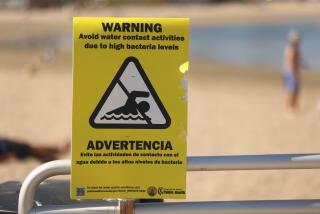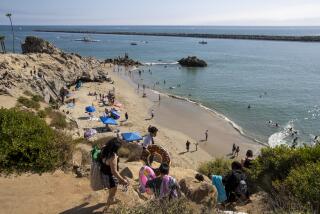Storm Fouls 3 South County Beaches
The first big rainstorm of the year left Southern California with crystal-clear skies and fresh-washed streets. But along the coast, dirty runoff from the storm left some beaches littered with debris and caused ocean pollution levels to spike.
Water tests from Ventura County’s southern coast detected three areas where bacteria levels exceeded state maximums: portions of McGrath Beach, Oxnard Beach and Point Mugu, said Richard Hauge, coordinator of the county’s Ocean Water Quality Monitoring Program. Health officials posted signs warning people to avoid the water.
“All we can do is advise,” Hauge said. “We can’t really force people out of the water.”
Results from the county’s northern coast, including its Ventura beaches, will be available today.
At one of those beaches, Surfers Point in Ventura, the post-storm conditions made the coastline look pristine Tuesday--green-blue water, balmy temperatures and a clear view of the Channel Islands.
But surfers said the storm also washed something into the ocean that was stinging their eyes.
“It’s so uncomfortable out there. You can’t shake it,” said Roger Rothwell, one of about 30 surfers in the water around noon.
Rothwell, 52, has been surfing 40 years and knows better than to paddle into the brown waves right after a major storm. But Tuesday’s conditions were too good to resist.
“We just can’t wait if they’re good waves,” he said. Surfing is “like breath. You gotta breathe.”
Bacteria levels normally run high after a storm. But because of the lack of rain in the Southland since January, there has been no natural flushing of such pollutants as engine oil and exhaust fumes that have settled on city streets.
Other pollutants flowing to the ocean include fertilizers and animal waste.
Along the Los Angeles County coast, weekend water pollution levels were the highest in a year and could take several more days before dropping, said Eric Edwards, an environmental health specialist with the county Health Department.
In Orange County, bacteria readings in ocean water tests performed over the weekend were so high that they exceeded the testing range of 16,000 organisms per 100 milliliter.
“It’s going off scale,” said Larry Honeybourne, with the county’s Health Care Agency.
Even though no Southern California beaches were closed, officials issued warnings to swimmers at more than three dozen, said Chad Nelsen, environmental director for the Surfrider Foundation.
The advisories suggest that swimmers avoid the ocean for at least 72 hours after a storm.
On Tuesday, lifeguards and beach operations were attacking yet another byproduct of the storm: the tons of trash that was swept off streets, down gutters and into the ocean.
“The beach is just covered with debris,” said Pete Driscoll, a Seal Beach lifeguard. “I took a walk down there at the water’s edge, and you can see everything from plants to plastic bottles to Styrofoam cups, even shoes.”
Seal Beach lies downstream of the San Gabriel River, which begins at the foothills of the San Gabriel Mountains and snakes its way through dozens of cities in Los Angeles County before reaching the ocean at Seal Beach.
“If you look at that river,” Driscoll said, “you can see the trash from millions of people floating on down from all the cities inland.”
More to Read
Sign up for Essential California
The most important California stories and recommendations in your inbox every morning.
You may occasionally receive promotional content from the Los Angeles Times.










